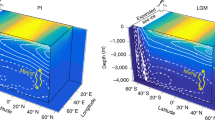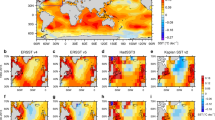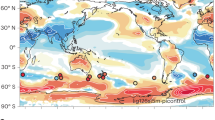Abstract
During the Middle Miocene climate transition about 14 million years ago, the Antarctic ice sheet expanded to near-modern volume. Surprisingly, this ice sheet growth was accompanied by a warming in the surface waters of the Southern Ocean, whereas a slight deep-water temperature increase was delayed by more than 200 thousand years. Here we use a coupled atmosphere–ocean model to assess the relative effects of changes in atmospheric CO2 concentration and ice sheet growth on regional and global temperatures. In the simulations, changes in the wind field associated with the growth of the ice sheet induce changes in ocean circulation, deep-water formation and sea-ice cover that result in sea surface warming and deep-water cooling in large swaths of the Atlantic and Indian ocean sectors of the Southern Ocean. We interpret these changes as the dominant ocean surface response to a 100-thousand-year phase of massive ice growth in Antarctica. A rise in global annual mean temperatures is also seen in response to increased Antarctic ice surface elevation. In contrast, the longer-term surface and deep-water temperature trends are dominated by changes in atmospheric CO2 concentration. We therefore conclude that the climatic and oceanographic impacts of the Miocene expansion of the Antarctic ice sheet are governed by a complex interplay between wind field, ocean circulation and the sea-ice system.
This is a preview of subscription content, access via your institution
Access options
Subscribe to this journal
Receive 12 print issues and online access
$259.00 per year
only $21.58 per issue
Buy this article
- Purchase on Springer Link
- Instant access to full article PDF
Prices may be subject to local taxes which are calculated during checkout



Similar content being viewed by others
References
Flower, B. P. & Kennett, J. P. The Middle Miocene climatic transition: East Antarctic ice sheet development, deep ocean circulation and global carbon cycling. Palaeogeogr. Palaeoclimatol. Palaeoecol. 108, 537–555 (1994).
Holbourn, A., Kuhnt, W., Schulz, M. & Erlenkeuser, H. Impacts of orbital forcing and atmospheric carbon dioxide on Miocene ice-sheet expansion. Nature 438, 483–487 (2005).
Langebroek, P., Paul, A. & Schulz, M. Antarctic ice-sheet response to atmospheric CO2 and insolation in the Middle Miocene. Clim. Past 5, 633–646 (2009).
Shevenell, A. E., Kennett, J. P. & Lea, D. W. Middle Miocene ice sheet dynamics, deep-sea temperatures, and carbon cycling: A Southern Ocean perspective. Geochem. Geophys. Geosyst. 9, Q02006 (2008).
Lear, C., Mawbey, E. & Rosenthal, Y. Cenozoic benthic foraminiferal Mg/Ca and Li/Ca records: Towards unlocking temperatures and saturation states. Paleoceanography 25, PA4215 (2010).
Billups, K. & and Schrag, D. P. Paleotemperatures and ice-volume of the past 27 Myr revisited with paired Mg/Ca and stable isotope measurements on benthic foraminifera. Paleoceanography 17, 1003 (2002).
Zachos, J. C., Pagani, M., Sloan, L., Thomas, E. & Billups, K. Trends, rhythms, and aberrations in global climate 65 Ma to present. Science 292, 286–293 (2001).
Langebroek, P., Paul, A. & Schulz, M. Simulating the sea-level imprint on marine oxygen-isotope records during the Middle Miocene using an ice sheet-climate model. Paleoceanography 25, PA4203 (2010).
Shevenell, A. E., Kennett, J. P. & Lea, D. W. Middle Miocene Southern Ocean cooling and Antarctic cryosphere expansion. Science 305, 1766–1770 (2004).
Foster, G. L., Lear, C. H. & Rae, J. W. The evolution of pCO2, ice volume and climate during the middle Miocene. Earth Planet. Sci. Lett. 341, 243–254 (2012).
Raymo, M. E. & Ruddiman, W. F. Tectonic forcing of late Cenozoic climate. Nature 359, 117–122 (1992).
Kennett, J. P. Cenozoic evolution of Antarctic glaciation, the circum-Antarctic Ocean and their impact on global paleoceanography. J. Geophys. Res. 82, 3843–3860 (1975).
Vincent, E. & Berger, W. H. in The Carbon Cycle and Atmospheric CO2: Natural Variations Archean to Present (eds Broecker, W. S. & Sundquist, E. T.) 455–468 (Geophysical Monograph Series 32, AGU, 1985).
Kump, L. R. & Arthur, M. A. Interpreting carbon-isotope excursions: Carbonate and organic matter. Chem. Geol. 161, 181–198 (1999).
Lear, C., Rosenthal, Y., Coxall, H. & Wilson, P. Late Eocene to early Miocene ice sheet dynamics and the global carbon cycle. Paleoceanography 19, 1–11 (2004).
Badger, M. P. et al. CO2 drawdown following the middle Miocene expansion of the Antarctic ice sheet. Paleoceanography 28, 42–53 (2013).
Kuhnert, H., Bickert, T. & Paulsen, H. Southern Ocean frontal system changes precede Antarctic ice sheet growth during the middle Miocene. Earth Planet. Sci. Lett. 284, 630–638 (2009).
Jungclaus, J. H. et al. Ocean circulation and tropical variability in the coupled model ECHAM5/MPI-OM. J. Clim. 19, 3952–3972 (2006).
Micheels, A. et al. Analysis of heat transport mechanisms from a Late Miocene model experiment with a fully-coupled atmosphere–ocean general circulation model. Palaeogeogr. Palaeoclimatol. Palaeoecol. 304, 337–350 (2011).
Knorr, G., Butzin, M., Micheels, A. & Lohmann, G. A warm Miocene climate at low atmospheric CO2 levels. Geophys. Res. Lett. 38, L20701 (2011).
Henrot, A. et al. Effects of CO2, continental distribution, topography and vegetation changes on the climate at the Middle Miocene: A model study. Clim. Past 6, 675–694 (2010).
Krapp, M. & Jungclaus, J. H. The Middle Miocene climate as modelled in an atmosphere–ocean– biosphere model. Clim. Past 7, 1169–1188 (2011).
Bradshaw, C. D. et al. The relative roles of CO2 and palaeogeography in determining late Miocene climate: Results from a terrestrial model–data comparison. Clim. Past 8, 1301–1307 (2012).
DeConto, R. M., Pollard, D. & Harwood, D. Sea ice feedback and Cenozoic evolution of Antarctic climate and ice sheets. Paleoceanography 22, PA3214 (2007).
Goldner, A., Huber, M. & Caballero, R. Does Antarctic glaciation cool the world? Clim. Past 9, 173–189 (2013).
DeConto, R. M. & Pollard, D. Rapid Cenozoic glaciation of Antarctica induced by declining atmospheric CO2 . Nature 421, 245–249 (2003).
Roeckner, E. et al. Sensitivity of simulated climate to horizontal and vertical resolution in the ECHAM5 atmosphere model. J. Clim. 19, 3771–3791 (2006).
Marsland, S. J., Haak, H., Jungclaus, J. H., Latif, M. & Röske, F. The Max-Planck-Institute global ocean/sea ice model with orthogonal curvilinear coordinates. Ocean Modelling 5, 91–127 (2003).
Tripati, A. K. et al. Coupling of CO2 and ice sheet stability over major climate transitions of the last 20 million Years. Science 326, 1394–1397 (2009).
van de Wal, R. S. W., de Boer, B., Lourens, L. J., Köhler, P. & Bintanja, R. Reconstruction of a continuous high-resolution CO2 record over the past 20 million years. Clim. Past 7, 1459–1469 (2011).
Acknowledgements
We thank S. Barker, I. Hall and P. Köhler for comments on this study and the colleagues in the Paleoclimate Dynamics group at the Alfred Wegener Institute Helmholtz Center for Polar and Marine Research (AWI) in Bremerhaven for general support. This study is promoted by the PACES programme of the AWI and by the Helmholtz Climate Initiative REKLIM (Regional Climate Change), a joint research project of the Helmholtz Association of German research centres (HGF).
Author information
Authors and Affiliations
Contributions
G.K. and G.L. designed the research. G.K. carried out the experiments. G.K. and G.L. carried out the analysis and wrote the paper.
Corresponding author
Ethics declarations
Competing interests
The authors declare no competing financial interests.
Supplementary information
Supplementary Information
Supplementary Information (PDF 9346 kb)
Rights and permissions
About this article
Cite this article
Knorr, G., Lohmann, G. Climate warming during Antarctic ice sheet expansion at the Middle Miocene transition. Nature Geosci 7, 376–381 (2014). https://doi.org/10.1038/ngeo2119
Received:
Accepted:
Published:
Issue Date:
DOI: https://doi.org/10.1038/ngeo2119
This article is cited by
-
Strength and variability of the Oligocene Southern Ocean surface temperature gradient
Communications Earth & Environment (2022)
-
Cores, edges and beyond: insights into the phylogeography of frigatebirds with a focus on ultraperipheral and endemic populations
Conservation Genetics (2022)
-
Hydrological impact of Middle Miocene Antarctic ice-free areas coupled to deep ocean temperatures
Nature Geoscience (2021)
-
Direct astronomical influence on abrupt climate variability
Nature Geoscience (2021)
-
A salty deep ocean as a prerequisite for glacial termination
Nature Geoscience (2021)



